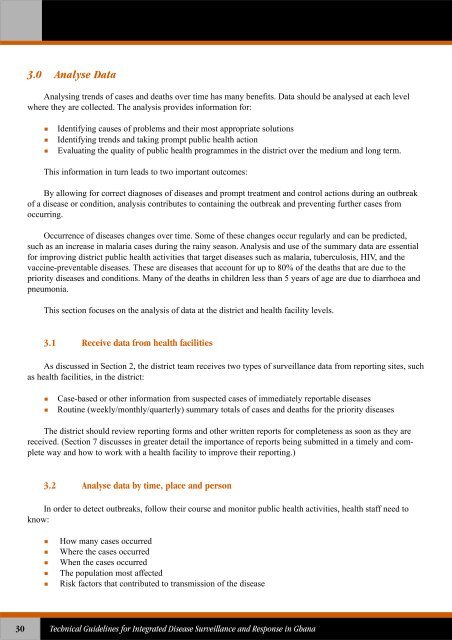Technical Guidelines for Integrated Disease Surveillance ... - PHRplus
Technical Guidelines for Integrated Disease Surveillance ... - PHRplus
Technical Guidelines for Integrated Disease Surveillance ... - PHRplus
You also want an ePaper? Increase the reach of your titles
YUMPU automatically turns print PDFs into web optimized ePapers that Google loves.
3.0 Analyse DataAnalysing trends of cases and deaths over time has many benefits. Data should be analysed at each levelwhere they are collected. The analysis provides in<strong>for</strong>mation <strong>for</strong>:Identifying causes of problems and their most appropriate solutionsIdentifying trends and taking prompt public health actionEvaluating the quality of public health programmes in the district over the medium and long term.This in<strong>for</strong>mation in turn leads to two important outcomes:By allowing <strong>for</strong> correct diagnoses of diseases and prompt treatment and control actions during an outbreakof a disease or condition, analysis contributes to containing the outbreak and preventing further cases fromoccurring.Occurrence of diseases changes over time. Some of these changes occur regularly and can be predicted,such as an increase in malaria cases during the rainy season. Analysis and use of the summary data are essential<strong>for</strong> improving district public health activities that target diseases such as malaria, tuberculosis, HIV, and thevaccine-preventable diseases. These are diseases that account <strong>for</strong> up to 80% of the deaths that are due to thepriority diseases and conditions. Many of the deaths in children less than 5 years of age are due to diarrhoea andpneumonia.This section focuses on the analysis of data at the district and health facility levels.3.1 Receive data from health facilitiesAs discussed in Section 2, the district team receives two types of surveillance data from reporting sites, suchas health facilities, in the district:Case-based or other in<strong>for</strong>mation from suspected cases of immediately reportable diseasesRoutine (weekly/monthly/quarterly) summary totals of cases and deaths <strong>for</strong> the priority diseasesThe district should review reporting <strong>for</strong>ms and other written reports <strong>for</strong> completeness as soon as they arereceived. (Section 7 discusses in greater detail the importance of reports being submitted in a timely and completeway and how to work with a health facility to improve their reporting.)3.2 Analyse data by time, place and personIn order to detect outbreaks, follow their course and monitor public health activities, health staff need toknow:How many cases occurredWhere the cases occurredWhen the cases occurredThe population most affectedRisk factors that contributed to transmission of the disease30<strong>Technical</strong> <strong>Guidelines</strong> <strong>for</strong> <strong>Integrated</strong> <strong>Disease</strong> <strong>Surveillance</strong> and Response in Ghana















